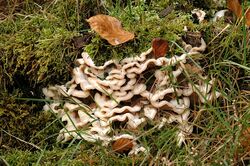Biology:Meruliaceae
| Meruliaceae | |
|---|---|

| |
| Phlebia tremellosa, member of the Meruliaceae | |
| Scientific classification | |
| Domain: | Eukaryota |
| Kingdom: | Fungi |
| Division: | Basidiomycota |
| Class: | Agaricomycetes |
| Order: | Polyporales |
| Family: | Meruliaceae Rea (1922) |
| Type genus | |
| Merulius Fr. (1821)
| |
| Synonyms[1] | |
| |
The Meruliaceae are a family of fungi in the order Polyporales. According to a 2008 estimate, the family contains 47 genera and 420 species.[2] (As of April 2018), Index Fungorum accepts 645 species in the family.[3]
Taxonomy
The family was formally circumscribed by English mycologist Carleton Rea in 1922, with Merulius as the type genus. He also included the genera Phlebia, Coniophora (now placed in the Coniophoraceae), and Coniophorella (now considered a synonym of Coniophora). His description of the Meruliaceae was as follows: "Hymenium spread over veins, anastomosing pores, or quite smooth; edge of veins or pores fertile."[4] Several genera formerly classified in the Meruliaceae were moved to the family Steccherinaceae based on molecular evidence.[5][6]
Description
Meruliaceae species are crust-like or polyporoid, and often have a waxy appearance when dry. Their hyphal systems are monomitic (containing only tightly arranged generative hyphae), and these hyphae have clamp connections. The spores are smooth, thin-walled, and hyaline (translucent). Cystidia are often present in the hymenium. Although rare, some species have a dimitic hyphal system (with both generative and skeletal hyphae). Meruliaceae fungi cause white rot.[1]
Genera
- Abortiporus Murrill (1904) – 3 species
- Amaurohydnum Jülich (1978) – 1 species
- Amauromyces Jülich (1978) – 1 species
- Aquascypha D.A.Reid (1965) – 1 species
- Aurantiopileus Ginns, D.L.Lindner & T.J.Baroni (2010)[7]
- Aurantiporus Murrill (1905) – 5 species
- Bjerkandera P.Karst. (1879) – 7 species
- Bulbillomyces Jülich (1974) – 1 species
- Cerocorticium Henn. (1900) – 7 species
- Chrysoderma Boidin & Gilles (1991) – 1 species
- Climacodon P.Karst. (1881) – 7 species
- Columnodontia Jülich (1979) – 1 species
- Conohypha Jülich (1975) – 2 species
- Coralloderma D.A.Reid (1965) – 3 species
- Crustoderma Parmasto (1968) – 18 species
- Crustodontia Hjortstam & Ryvarden (2005) – 1 species
- Cyanodontia Hjortstam (1987) – 1 species
- Cymatoderma Jungh. (1840) – 1 species
- Diacanthodes Singer (1945) – 3 species
- Elaphroporia Z.Q.Wu & C.L.Zhao (2018)[8] – 1 species
- Gyrophanopsis Jülich (1979) – 2 species
- Hydnophlebia Parmasto (1967)– 2 species
- Hyphoderma Wallr. (1833) – 104 species
- Hyphodontiastra Hjortstam (1999) – 1 species
- Hypochnicium J.Erikss. (1958) – 35 species
- Lilaceophlebia (Parmasto) Spirin & Zmitr. (2004) – 3 species
- Luteoporia F.Wu, Jia J.Chen & S.H.He (2016)[9] – 1 species
- Merulius Fr. (1821) – 2 species
- Mycoacia Donk (1931) – 17 species
- Mycoaciella J.Erikss. & Ryvarden (1978) – 5 species
- Mycoleptodonoides Nikol. (1952) – 6 species
- Niemelaea Zmitr., Ezhov & Khimich (2015)[10] – 3 species
- Odoria V.Papp & Dima (2018)[11] – 1 species
- Phlebia Fr. (1821) – 89 species
- Phlebiporia Jia J.Chen, B.K.Cui & Y.C.Dai (2014)[12] – 1 species
- Pirex Hjortstam & Ryvarden (1985) – 1 species
- Podoscypha Pat. (1900) – 39 species
- Radulodon Ryvarden (1972) – 11 species
- Sarcodontia Schulzer (1866) – 6 species
- Scopuloides (Massee) Höhn. & Litsch. (1908) – 5 species
- Stegiacantha Maas Geest. (1966) – 1 species
- Uncobasidium Hjortstam & Ryvarden (1978) – 2 species
References
- ↑ 1.0 1.1 Justo, Alfredo; Miettinen, Otto; Floudas, Dimitrios; Ortiz-Santana, Beatriz; Sjökvist, Elisabet; Lindner, Daniel; Nakasone, Karen; Niemelä, Tuomo et al. (2017). "A revised family-level classification of the Polyporales (Basidiomycota)". Fungal Biology 121 (9): 798–824. doi:10.1016/j.funbio.2017.05.010. PMID 28800851.
- ↑ Kirk, P.M.; Cannon, P.F.; Minter, D.W.; Stalpers, J.A. (2008). Dictionary of the Fungi (10th ed.). Wallingford, UK: CABI. p. 419. ISBN 978-0-85199-826-8.
- ↑ Kirk, P.M., ed. "Species Fungorum (version 28th March 2018). In: Species 2000 & ITIS Catalogue of Life". http://www.catalogueoflife.org/col/browse/tree/id/48bbf70a6d07554c0a8113bfa2a04e97. Retrieved 2018-04-09.
- ↑ Rea, Carleton (1922). British Basidiomycetae: A Handbook to the Larger British Fungi. Cambridge, UK: Cambridge University Press. p. 620. https://www.biodiversitylibrary.org/page/17128455.
- ↑ Miettinen, Otto; Larsson, Ellen; Sjökvist, Elisabet; Larsson, Karl-Henrik (2012). "Comprehensive taxon sampling reveals unaccounted diversity and morphological plasticity in a group of dimitic polypores (Polyporales, Basidiomycota)". Cladistics 28 (3): 251–270. doi:10.1111/j.1096-0031.2011.00380.x. PMID 34872189. https://www.researchgate.net/publication/256859903.
- ↑ Miettinen, Otto; Ryvarden, Leif (2016). "Polypore genera Antella, Austeria, Butyrea, Citripora, Metuloidea and Trulla (Steccherinaceae, Polyporales)". Annales Botanici Fennici 53 (3–4): 157–172. doi:10.5735/085.053.0403.
- ↑ Ginns, James; Lindner, Daniel L.; Baroni,Timothy J.; Ryvarden, Leif (2010). "Aurantiopileus mayanensis a new genus and species of polypore (Polyporales, Basidiomycota) from Belize with connections to existing Asian species". North American Fungi 5: 1–10. doi:10.2509/naf2010.005.004.

- ↑ Wu, Zi-Qiang; Xu, Tai-Min; Shen, Shan; Liu, Xiang-Fu; Luo, Kai-Yue; Zhao, Chang-Lin (2018). "Elaphroporia ailaoshanensis gen. et sp. nov. in Polyporales (Basidiomycota)". MycoKeys 29 (29): 81–95. doi:10.3897/mycokeys.29.22086. PMID 29559827.
- ↑ Wu, Fang; Yuan, Yuan; Chen, Jia-Jia; He, Shuang-Hui (2016). "Luteoporia albomarginata gen. et sp. nov. (Meruliaceae, Basidiomycota) from tropical China". Phytotaxa 263 (1): 31–41. doi:10.11646/phytotaxa.263.1.3.
- ↑ Zmitrovich, Ivan V.; Ezhov, Oleg N.; Khimich, Yulia R. (2017). "Niemelaea, a new genus of Meruliaceae (Basidiomycota)". Agriculture and Forestry 61 (4): 23–31. doi:10.17707/AgricultForest.61.4.02.
- ↑ Papp, Viktor; Dima, Bálint (2018). "New systematic position of Aurantiporus alborubescens (Meruliaceae, Basidiomycota), a threatened old-growth forest polypore". Mycological Progress 17 (3): 319–332. doi:10.1007/s11557-017-1356-3.
- ↑ Chen, Jia-Jia; Cui, Bao-Kai (2014). "Phlebiporia bubalina gen. et. sp. nov. (Meruliaceae, Polyporales) from southwest China with a preliminary phylogeny based on rDNA sequences". Mycological Progress 13 (3): 563–573. doi:10.1007/s11557-013-0940-4.
Wikidata ☰ Q2502557 entry
 |

